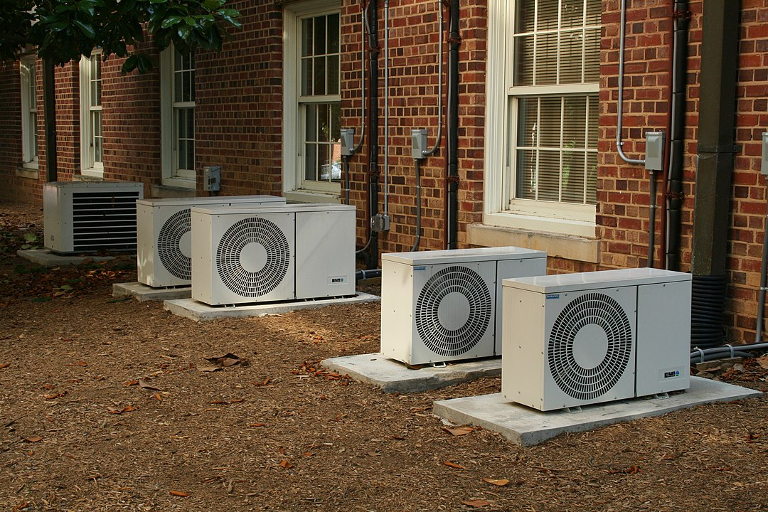A wave of persistent, intense heat and humidity has enveloped the Midwest, South, and Northeast in this second half of July. By the time it subsides, more than half of the U.S. population will have been hit with heat indexes above 100; for many, the heat wave will last for several days.
The severe heat is driving almost all social gatherings and group activities into enclosed, air-conditioned spaces. That’s been the American way for more than fifty summers now, but this summer is different. Getting together these days in the cool indoor world can dramatically raise the risk of coronavirus infection.
For the duration of this pandemic, it will always be riskier to gather indoors than outdoors. In a paper published by the journal Clinical Infectious Diseases last month, more than 240 scientists warned that in an enclosed space, airborne, virus-laden “microdroplets” exhaled by an infected person can easily travel the length of a room and be inhaled by another person. Social distancing of six feet between people, they wrote, offers little protection in such a situation.
One of the scientists’ chief recommendations was to keep occupied rooms well ventilated with outdoor air, most effectively by keeping windows open. But air-conditioned spaces have to be zipped up tight, allowing airborne droplets to accumulate.
Air conditioning raises the risk further by lowering the indoor relative humidity. Studies show that coronaviruses in general, including those that cause the common cold, SARS, and MERS, remain viable and infective longer when humidity is low, whether they’re in the air or on surfaces.
There’s more. When humidity is high, exhaled virus particles are carried inside bulky droplets that fall to the floor or other surfaces within seconds. But with low humidity, they are in much smaller droplets called aerosols that can stay aloft in an enclosed space for as long as 9 minutes, waiting to be inhaled.
Some types of cooling systems also serve to circulate aerosols very efficiently and infect large numbers of people. A widely cited case study found that in January, one customer at a restaurant in Guangzhou, China infected nine other diners at three different tables with coronavirus. The breeze from an air conditioner near one of the tables had efficiently distributed virus-laden droplets along a twenty-foot-long path.
Air conditioning also can aggravate more routine maladies, including nasal congestion, asthma, and allergies. Studies in North and South America and Europe have found that people employed in air-conditioned workplaces have more health problems than those who work in non-cooled spaces.
Despite such impacts, air conditioning is customarily viewed as a net health benefit, because it can help prevent deaths during heat waves. However, research shows that heat deaths occur predominantly in marginalized, economically stressed urban areas with too much concrete and too little vegetation, often in communities of color who have inadequate access to services, especially health care.
Those who die in heat waves also are often elderly and/or have preexisting health problems, and they may be unable to afford the electricity to run an air conditioner. Not coincidentally, these communities and individuals who are most vulnerable to heat waves are also the most vulnerable to the coronavirus.
To be clear, air conditioning can indeed help keep people alive under harsh conditions, and that is no small thing. Nevertheless, it is important for us to acknowledge that in that role, the air conditioner is an in-case-of-emergency-break-glass tool. It’s not designed to fix the underlying social and economic injustices from which people need to be rescued, whether it’s from extreme heat or a viral pandemic.
Air conditioning is increasingly viewed as a key technology for adaptation to climate change, which is ironic because it also accelerates greenhouse warming. It accounts for 17 percent of year-round home electricity consumption and the resulting emissions; furthermore, the Energy Information Agency predicts that U.S. energy use for air conditioning will grow faster than any other use of energy in buildings of all kinds in coming decades.
The chain of causation forms a perfect circle. Greenhouse emissions from past decades (including billions of tons of carbon dioxide emitted by air conditioning, aircraft, and other technologies that also happen to be implicated in the pandemic) have made summers hotter than ever, prompting even more air conditioning use, which will further increase greenhouse emissions. Those emissions will help ensure that future summers are even hotter and future air-conditioning systems are pushed even harder.
Ending the climate emergency will require the rapid, mandatory reduction of fossil fuel use to zero and a complete overhaul of our built environment—including good, affordable housing and a healthy environment for all.
Meanwhile, we can at least curb the short-term damage. Home air conditioning should be turned off on those many days of the year when shade and fans can provide sufficient comfort. Offices should never be so frigid that workers resort to wearing sweaters or keeping space heaters under their desks in July. Every building should have windows that can be opened and that stay open as much as possible.
And, at least for the rest of this summer, let’s all get together outdoors.
Ed. note: A slightly different version of this article was originally published by The Hill.
Teaser photo credit: By Ildar Sagdejev (Specious) – Own work, CC BY-SA 4.0, https://commons.wikimedia.org/w/index.php?curid=4370335






